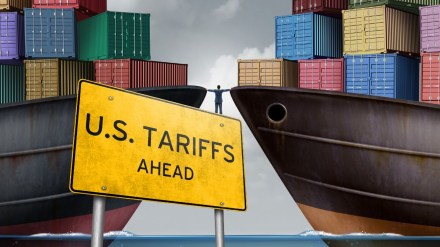The India-US trade imbroglio continues. While all eyes are on August 7, the new date from which the 25% Trump tariff will be applicable, SBI Reseach has come out with a bold statement. They have said that this current salvo of tariffs plus penalty from US President, Donald Trump is a “bad business decision.” Moreover, they believe “the impact on the US will be worse compared to India with a lower GDP, higher inflation, and a weaker dollar.”
In a detailed 25-page report, SBI Research outlines that India may be shaken by the 25% tariff announcement but not “stirred.” They explained that “the mysterious forces of the global supply chain should auto-adjust and cushion the impact… Indian businesses and firms would do well to reinvigorate the ‘Made In India’ as a hallmark of unquestionable quality.”
The report further elaborated and compared the two economies, Indian and US, and claimed that “not surprisingly US GDP, inflation, and currency face greater risk of downgrades compared to India.”
India-US trade stalemate: Trade talks are an incorrect lever, says SBI
SBI Research says the current stalemate in trade talks is due to political reasons, and “trade talks are an incorrect lever in the fallacies of the current regime.”
The report highlighted that “the strategic positioning of brand India, the economic juggernaut, and military prowess now ringing alarm bells could be one of the reasons for the House of Cards being built, which can temporarily checkmate our journey but would do little to stifle our spirits or the can-do mentality.”
It goes on to elaborate further on the timing of the decision to impose the tariff. It comes at a time when Donald Trump’s rating as President of US is near all-time lows. It is currently at 37%, just a tad higher than the all-time low of 34%.
Economic implications of tariff: US Vs India
SBI Research then launches a blow-by-blow analysis of the tariff implementation on the economies of both nations—India and the US.
Impact on US Economy: Boomerang effect if tariffs
Highlighting the impact on US economy, SBI Research pointed out that US is beginning to show renewed inflationary pressure, and the pass-through effect of the current tariff announcements needs to be analysed in detail. They warn of the possibility of a boomerang effect on the US economy, given the supply shock as a result of the tariff and its impact on intermediate costs.
“The economic implications for the current trade stalemate..not surprisingly the impact on US will be worse compared to India with a lower GDP and higher inflation and a weaker dollar,” they explained.
According to their study, “US inflation is expected to stay above the 2 per cent target through 2026, driven by supply-side effects of tariffs and exchange rate movements.” They highlighted that the total US imports from the rest of the world stood at approximately $3,266 billion. The newly announced average tariff rate is assumed to be 20% across all imports. Thus, the tariff shock applies to nearly the entire import volume.
As per their calculation, “We estimate the inflationary effect of tariffs imposed by the US on its imports. Specifically, we quantify how much these tariffs will contribute to US CPI in both the short run (before substitution and supply chain adjustment) and the long run (after markets partially adjust to new trade costs).”
Tariff impact on US GDP
SBI Research expects “tariffs on US imports are set to affect US GDP by 40-50 bps and higher input cost inflation.”
A detailed formula-driven calculation on the current cost over the short term and long term by them “suggests that in the absence of supply chain re-optimisation or domestic substitution, the tariffs could push US inflation up by 2.4%. In the long run, when economic actors have had time to adjust to the new trade regime, the tariffs are expected to add 1.2% to baseline inflation.”
US tariffs are projected “to cost the average US household about $2,400 in the short-term, mainly due to higher prices from tariff-driven inflation. Low-income families may lose around $1,300, nearly triple the relative burden compared to high earners, while high-income households could face losses of up to $5,000, though with less impact on their overall financial stability,” they added.
Economic implications of tariff on India
In comparison, let’s understand how the tariff, if implemented as is, is going to impact India. Though the US is India’s top exporter with a 20% share in FY25, “India has diversified its export destinations, and the top 10 countries only accounted for 53% of total exports,” explained SBI Research. Current trade dynamics show trade, in fact, has not slowed down, even after the 10% tariff imposition.
The US share in India’s exports reached 20% in FY25 and is “expected to be 22.4% in FY26,” as per SBI Research. The top 15 items exported to the US accounted for 63% of total exports. But the 25% tariff by the US is “expected to impact India’s GDP growth by 25–30bps for FY26,” as per SBI Research. This is significantly lower than the projected impact on US GDP
Moreover, most of the Asian countries face higher tariff rates compared to India at present, and it needs to be seen how much reduction India can manage after the next round of talks.
Tariff unlikely to favour either India or US
Broadly neither economy—India nor the US—stands to gain from the 25% tariff. India losing the ‘most favoured nation’ may cut down the competitive edge of many sectors that are beneficiaries, like diamonds, smartphones, and pharma products. The Indian Government could look at reducing tariffs on some sectors like automobiles, capital goods, man-made fibre, and alcoholic beverages.
However, the overall impact on the US economy is significantly more adverse compared to India. Drug shortages and increases in prices of daily essentials is seen as another big red flag for the US economy.
